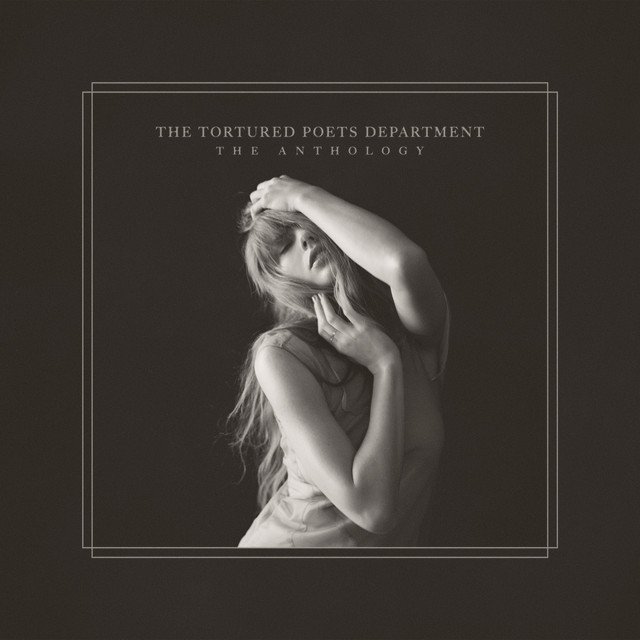Taylor Swift’s The Tortured Poets Department is her Most Unfiltered Era to Date
On February 4, 2024, at the 66th Annual Grammy Awards, Taylor Swift announced the release date for her new album, The Tortured Poets Department (TTPD). That night consolidated a new peak for her career, as she won the Album of the Year award for her album Midnights and broke Frank Sinatra’s record in that category. Furthermore, the immense popularity of the Eras Tour and its movie amassed an unprecedented status of fame for her.
The album TTPD caused a lot of anticipation before its release date on April 19th, since it would be Swift’s first official breakup album since Red in 2012. Reminiscing and reflecting on her personal life in a diaristic way had become a characteristic of Swift’s music. However, during her 6-year-long relationship with British actor Joe Alwynn, she opted to create fictional stories in albums like Folklore and Evermore, and even Midnights, which was comprised of events throughout her life, had ambiguous lyrics regarding personal details.
Following Swift and Alwynn’s breakup, many expected the new album to be a contemplation of their long relationship, especially considering Swift had dedicated Alwynn so many romantic songs such as “Lover” or "Invisible String". The fans started speculating many things, like detectives analyzing the evidence: Some found a video of Alwynn talking about his group chat, “The Tortured Man Club”, and linked it to the album’s name; others theorized about possible affairs and looked for clues in Alwynn costars’s social media.
When TTPD was released and we were able to finally listen to the album, Swift pulled a shocking, unexpected plot twist. Instead of Joe Alwynn, most of the album seems to focus on her fleeting love affair (or “mutual manic phase”, according to Swift herself) with British musician Matty Healy, vocalist of pop rock band The 1975.
Beyond the men, Swift’s new album focuses on how fame, the media, and her parasocial relationship with her fans impacted her in a moment in which her mental health was tumultuous. Many fans had opposed her association with Healy because of his controversial past, to the point some created the #SpeakUpNow campaign requesting Swift to end the relationship; which eventually happened a few weeks later.
What many locals to her music ignore, is that Swift injects a lot of humor into her songs. In this album, Swift is at her most unfiltered and ironic. She mocks herself and the whole concept of the album as pretentious in the title track, in which she says “Who uses typewriters anyway?”. In “But Daddy I love him”, she seems to be making fun of the people who opposed her relationship with Healy, calling them “vipers in empath’s clothing” and breaking the fourth wall with a pregnancy prank. In “I Can Fix Him (No Really I Can)”, she insists she can help her partner become a better person until she admits: “Whoah, maybe I can’t.”
Swift ventures into how attaining such an unprecedented amount of fame has affected her in a raw way. In “I Can Do It with a Broken with a Broken Heart”, she admits in the boppiest melody ever that she feels depressed and copes by overworking herself, as her fans ask her for “more” all the time. In “Clara Bow”, she reflects on how the entertainment industry searches for women to turn into the “it girl” of a generation to the point of idealization and worship, in a never ending cycle where real-life women are lost into an idea.
Sonically, most songs are very similar: they have a slow to mid-tempo, synth beats, and sometimes piano or guitar. More dynamic songs like “I Can Do It with a Broken Heart” or “Florida!!!” (ft. Florence+Machine) provide a much-needed change of pace given the subject of heartbreak. Since Swift’s main draw is her lyrics, sometimes the production neglects to add instrumental breaks, which could help the listener process the emotions described in the songs.
The ‘The Tortured Poets Department’ era is marked by the chaos of a transitional period of Swift’s life. In the music video for the lead single, “Fortnight (ft.Post Malone), she satirically depicts herself as an unstable person in an asylum, who must take “forget him” pills to heal.
Artistically, it is bold that Swift shared the music she made during a self-admittedly manic episode. Throughout her career, music has been how she processes her emotions and can overcome negative feelings. TTPD serves as a time capsule from that moment in her life once she has moved on from it, and it is charged with self-deprecating humor regarding the outcomes of her breakup and disastrous rebound. Additionally, she surprised her fans once again by dropping a secret second part, The Anthology, two hours later. The second part is comprised of 15 more songs, doubling the album. Truly, it is undeniable that a major reason for the ongoing “Swiftmania” is her capacity to release new music non-stop. This is her fourth album of the decade (not counting her rereleases), and fans are still asking for more (When is “Reputation (Taylor’s Version” coming?).
Strike Out,
Sofía Ramírez
Blog Editor: Priscilla Fernandez

